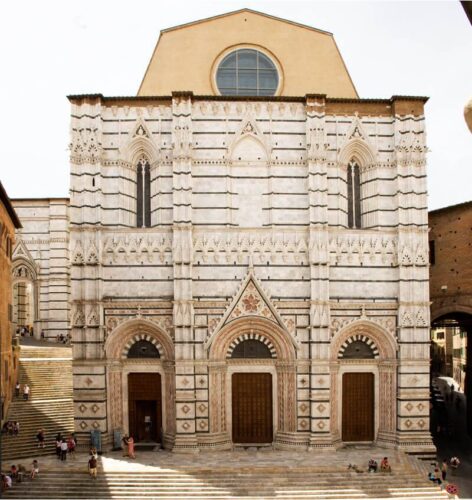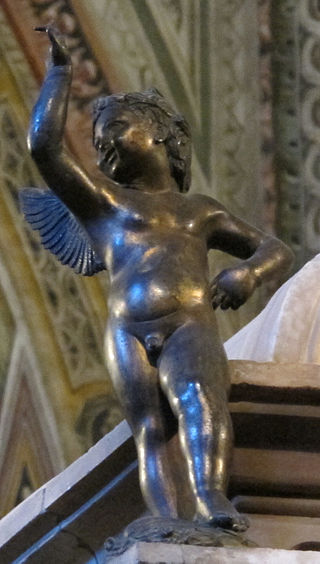Battistero di San Giovanni
Through a door into the north wall of the uncompleted Duomo Nuovo (New Cathedral) a steep marble staircase will lead you down to the Piazza San Giovanni and the Battistero di San Giovanni that gave the piazza its name. The Battistero was built on the back of the Duomo’s choir, adjacent to its closing wall. A carved cross on one of the first steps commemorates a legend associated with St. Catherine of Siena, who allegedly fell here from a devil’s push.
The initial idea was to extend the apse of the Cathedral but since the ground, after its closing wall descended steeply it was decided that a new building was to be built and its roof would support the floor of the new spans of the choir of the Cathedral. It would house the new baptistery.



Work began in 1317 and was entrusted to Camino di Crescentino, a master builder who had just completed his work in the upper part of the facade of the Duomo. By 1325 the basic elements were in place. Most of the exterior marbles were also incorporated before the end of the 14th. The typical Sienese Gothic style of its exterior was succeeded by the glorious renaissance frescoes, reliefs, and sculptures of its interior added mostly throughout the 15th century with new additions continuing up to the 20th century (main altar).
Lorenzo di Pietro, known as Vecchietta painted the Twelve Articles of the Christian Faith on the vaults between 1447 and 1450 and then proceeded on the triumphal arch framing the apse, where he painted the Assumption of the Virgin in Glory with Angels and on the lower part of the apse, the Annunciation. On the sides, he painted two scenes from the Passion of Christ: the Flagellation and the Ascent to Calvary


The Agony in the Garden, the Crucifixion, and the Deposition in the Tomb on the apse proper were painted by Matteo Lambertini in 1447. On the north wall, Benvenuto di Giovanni painted the Miracles of St. Anthony of Padua around 1460 while on the south Pietro di Francesco degli Orioli painted the Washing of the Feet in 1489.
The most striking image inside the baptistery comes from its most celebrated work of art by both experts and lovers alike. The amazing product of the collaboration of four of the greatest sculptors of the early 15th century that stands right at the center of the Baptistery.
The Baptismal Font consists of a hexagonal basin/tub attributed to Jacopo Della Quercia (ca. 1374-1438) who also designed and executed the marble pillar and the carved reliefs of the prophets and the statue of Saint John the Baptist on top of it all. Also, six gilded bronze panels, are attached to the basin, depicting scenes from the life of St. John the Baptist created by the renowned Florentine artists, Donatello and Lorenzo Ghiberti and Turino di Sano and his son Giovanni di Turino from Siena.


The most famous of all the reliefs is the famous Feast of Herod by Donatello (1427), a masterpiece within a masterpiece. The four bronze putti on the top, the dancing angels looking towards the altar, are the works of Giovanni di Turino and those of the right Donatello ( 1424 ). The fifth Putto with Tambourine of Donatello is now at the Bode Museum in Berlin; a sixth dancing Cherub, attributed to Donatello, is perhaps a work discarded for the series or a test and is now in the Bargello Museum.




